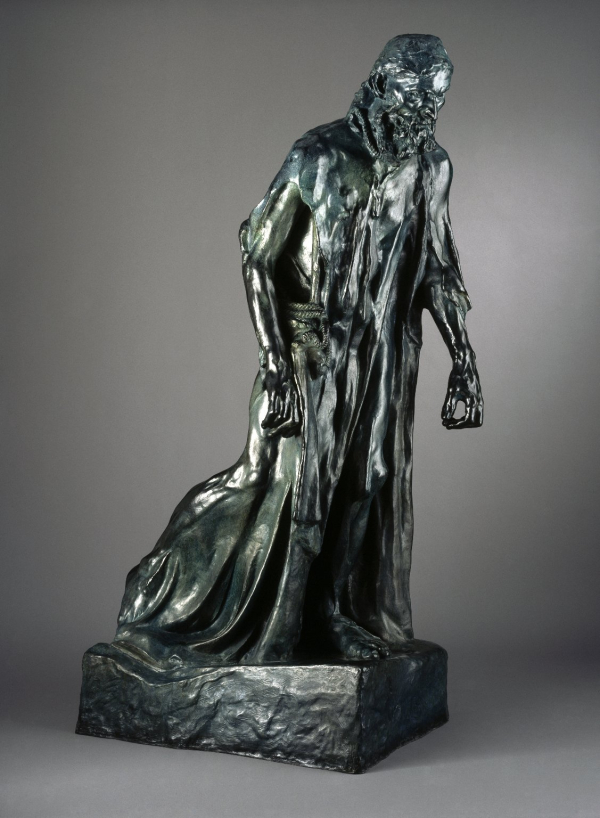
Auguste Rodin (French, 1840–1917). Pierre de Wiessant, Monumental (Pierre de Wissant, monumental), 1887, cast 1979. Bronze, 845⁄8 x 46 × 39 in. (214.9 × 116.8 × 99.1 cm). Brooklyn Museum, Gift of Iris and B. Gerald Cantor, 84.243

Auguste Rodin (French, 1840–1917). Pierre de Wiessant, Monumental (Pierre de Wissant, monumental), 1887, cast 1979. Bronze, 845⁄8 x 46 × 39 in. (214.9 × 116.8 × 99.1 cm). Brooklyn Museum, Gift of Iris and B. Gerald Cantor, 84.243

Auguste Rodin (French, 1840–1917). Pierre de Wiessant, Monumental Nude (Pierre de Wissant, nu monumental), 1886, cast 1983. Bronze, 781⁄4 x 443⁄4 x 361⁄2 in. (198.8 × 113.7 × 92.7 cm). Brooklyn Museum, Gift of the B. Gerald Cantor Collection, 86.310
Pierre de Wiessant was one of the heroic citizens of Calais who offered their own lives to spare the destruction of the city by the English army. For the monumental group The Burghers of Calais, Rodin first made nude figure studies, which he then draped in wet canvas to model the sackcloth worn by the burghers when they surrendered. To create the most expressive figures possible, he used the radical technique of combining studies of hands and feet from different figures. Creating the very antithesis of conventional heroic sculpture, Rodin here set out the terms of a modern, anti-monumental tradition that resonates to this day.

Auguste Rodin (French, 1840–1917). Andrieu d’Andres, Monumental (Andrieu d’Andres, monumental), 1888, cast 1983. Bronze, 783⁄8 x 50 × 331⁄2 in. (199.1 × 127 × 85.1 cm). Brooklyn Museum, Gift of Iris and B. Gerald Cantor, 87.106.3
In his first maquette for the sculpture commissioned by the city of Calais in 1884, Rodin proposed a conventional monument, with his figures united as a group on a tall pedestal. By the following year, however, the six figures were placed on a low rectangular plinth, at the same level as the viewer. As Rodin later wrote: “I wanted to have my statues placed in front of the Calais city hall on the very paving of the square like a living rosary of suffering and sacrifice.” The overwhelming grief, suffering, and humility captured in the figure of Andrieu d’Andres accentuate the feelings of nobility and sacrifice conveyed by the assembled group.

Auguste Rodin (French, 1840–1917). Eustache de Saint-Pierre, Monumental (Eustache de Saint-Pierre, monumental), circa 1886–87. Bronze, 85 × 30 × 48 in. (215.9 × 76.2 × 121.9 cm). Brooklyn Museum, Gift of Iris and B. Gerald Cantor, 87.106.2
In the wake of its humiliating defeat at the hands of Prussia in 1870, the French Third Republic sought to reinvigorate notions of heroism and citizenship. To this end, in 1884 the city council of Calais commissioned Rodin to create a monument to Eustache de Saint-Pierre. In 1347, while Calais was under siege by the English, Eustache and five other important citizens of the town had offered themselves as hostages, pleading for mercy for their long-suffering city.
The English king, Edward III, agreed to the exchange, and wearing nooses around their necks, the burghers marched out to meet their fate. They were spared, however, by the intervention of the king’s pregnant wife, Queen Philippa, who feared their deaths would be a bad omen for her child.
Rodin: The Cantor Gift to the Brooklyn Museum
September 19, 2006–February 19, 2016
This presentation of twelve bronze sculptures from our large holdings by Auguste Rodin includes The Age of Bronze, a signature conception from the early years of the sculptor’s career, as well as other works from his most significant commissions, including The Burghers of Calais, The Gates of Hell, and the Monument to Balzac. These casts came to us through the generosity of Iris and B. Gerald Cantor.